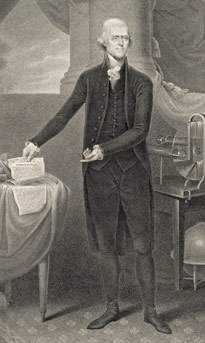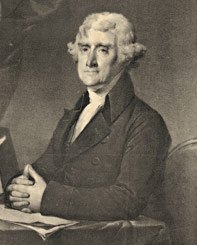Thomas Jefferson & Cheese
Thomas Jefferson and Parmesan Cheese in America
A case could be made that one of the American founding fathers, Thomas Jefferson, helped popularize Italy’s Parmesan cheese in America.
It seems likely that Thomas Jefferson, an educated man who enjoyed living well, had tasted Parmesan cheese in American homes even before becoming the U.S. ambassador to France. He took up this post in 1786, long before Parmesan began to be called Parmigiano Reggiano® cheese.
High-powered Parmesan Grater
 Once established in Paris, Thomas Jefferson spent much of his free time researching European technology that might be beneficial to the young union of American states. A “steam-powered grater” that reduced a quarter wheel of Parmesan to a snowy pile of grated cheese in minutes was of particular interest to him.
Once established in Paris, Thomas Jefferson spent much of his free time researching European technology that might be beneficial to the young union of American states. A “steam-powered grater” that reduced a quarter wheel of Parmesan to a snowy pile of grated cheese in minutes was of particular interest to him.
The inventor of the device, Gianbernardo Barbieri, a native of Parma living in Paris, advised Thomas Jefferson to do his utmost to bring Parmesan cheese to America.
In 1787 Thomas Jefferson set off on a 1200-mile journey to southern France and northern Italy to study viticulture, rice production and the making of Parmesan cheese. Perhaps he was exploring the possibility of making this exceptional cheese in America.
More Cheese Research by Thomas Jefferson
 Not content with the information about Parmesan cheese gathered on this trip, Thomas Jefferson sent an emissary back the following year to ferret out more details about Parmesan production. In particular, he gathered information on the Parmesan produced by the Dukes of Parma, the art practiced by local dairy workers and the care and feeding of their dairy cows.
Not content with the information about Parmesan cheese gathered on this trip, Thomas Jefferson sent an emissary back the following year to ferret out more details about Parmesan production. In particular, he gathered information on the Parmesan produced by the Dukes of Parma, the art practiced by local dairy workers and the care and feeding of their dairy cows.
Thomas Jefferson’s research also revealed that no responsible sea captain departs from Genoa without laying in a good supply of Parmesan cheese, providing nutrition to the crew and helping to protect against scurvy.
Eventually Thomas Jefferson abandoned any thoughts of making Parmesan cheese in America, recognizing that the cheese’s link to its origin in Italy was too strong. Instead, he imported it to enjoy on his table in the “President’s House”—an 1806 shipping document lists Parmesan cheese among the foods ordered for Thomas Jefferson’s French chef.
Macaroni Pie in America
Thomas Jefferson had acquired a mold for making “macaroni pie” and most likely this dish contained Parmesan cheese. Essentially, it was a Colonial version of our macaroni and cheese!
The first written recipe for macaroni pie seems to have come from The Experienced English Housekeeper, by Mrs. Elizabeth Raffald, published in 1769. It called for macaroni to be cooked and mixed with a béchamel sauce and Cheddar, then sprinkled with Parmesan cheese and baked to bubbly brown perfection.
After Thomas Jefferson
Historical evidence suggests that Thomas Jefferson was not the only American enjoying sophisticated fare such as Parmesan cheese in Colonial times. To use Savannah as an example: Ads and import records in the earliest newspaper, The Georgia Guardian, are filled with cosmopolitan fare such as wines from mainland Europe and Madeira, cordials, Italian olives, chocolate, tea and, significantly, large quantities of cheese. Because Parmesan cheese was widely distributed throughout Europe in this period, one can reasonably speculate that it was among these imports.
By the time of Savannah cookbooks such as Mrs. Hill’s New Cook Book, in 1857, Parmesan is mentioned casually, suggesting that the cheese was familiar fare. In urban areas where Italian immigrants settled, Parmesan wheels were especially likely to be imported.
Parmesan, a Treasure Island Treat
The great American adventure novelist, Robert Louis Stevenson, singled out Parmesan as the cheese of choice for a character in his 1883 classic, Treasure Island. Rather than indulging in snuff, he uses his snuffbox to carry a piece of Parmesan cheese, describing it as “a cheese made in Italy, very nutritious.”
At the outset of World War II, Americans, who had become familiar with Parmesan cheese and knew that it came from Italy, were unable to obtain Parmigiano Reggiano. The war brought an end to imports of this much wanted cheese, and imitations began to spring up.
Shakeable Cheese Leads to Consumer Confusion
In the ‘50s, when convenience foods became popular, hard grating cheese was dehydrated and placed in shaker cans that could be stored at room temperature.
This cheese tasted very different from Parmigiano Reggiano because it had a much higher sodium content and contained preservatives to keep it from caking. Certainly this is a cheese Thomas Jefferson would never have recognized as his beloved Parmesan!
Parmesan Returns to America
As Italian cooking came into vogue in the ‘60s and ‘70s, grated hard cheese packed in cans was the most readily available for sprinkling over pasta and other dishes. Over time, however, Americans learned more about regional Italian cooking and the importance of using authentic ingredients.
Americans’ new love affair with the cooking of Italy stimulated imports of the essential Parmesan cheese: Parmigiano Reggiano. We’ve come full circle, celebrating the same cheese prized by Thomas Jefferson!